The attorney/prisoner interview room has been a hot topic during recent courthouse space programming efforts. Historically, the attorney/prisoner interview room, if one even exists, has been located in the basement within the central cellblock. While it is undoubtedly appropriate to find interview rooms in the main cellblock for security reasons, I would like to discuss why many county courts request at least one attorney/prisoner interview room near the courtroom.I'd like to first briefly explain the purpose and layout of a typical attorney/prisoner interview room. The space is used for quick, private conferences between attorneys and an in-custody defendant on the day of a hearing – typically an arraignment – to discuss a procedural issue or plea. Prior discussions to prepare for the case may have also occurred in the jail, but ongoing communication is generally needed on the day of the hearing.
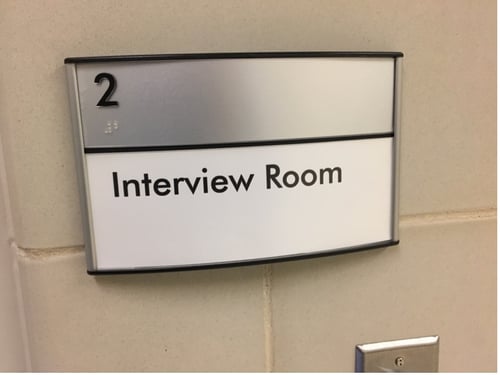
Unlike a typical attorney conference room located near a courtroom and used for attorneys to meet with non-custody defendants, witnesses, and family members, an attorney/prisoner interview room must be configured to provide security that meets prisoner handling requirements. Access to the space should be provided via secure circulation for the prisoner and separate public or restricted circulation for the attorney. Such a room is typically divided by a transparent perforated stainless steel mesh screen that allows for sound transmission or one that has a speak hole so the parties can converse with one another. The secure side of the room should be constructed of glazed block wall construction to the underside of the deck, and a secure ceiling should be provided. A stainless steel work surface and seat should be provided at the window. The seat should be secured to either the floor or the wall so it cannot be moved. Camera surveillance should be provided, and a signal light could be provided outside the room (on both sides) to indicate when the room is in use.
Examples of an attorney/prisoner interview room and the appropriate relationship to circulation are shown in the figures below.
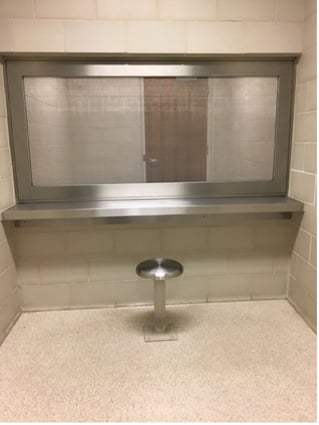
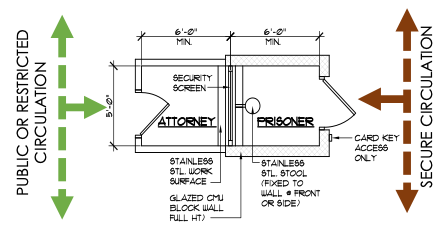
Due to these rigorous security requirements, it makes sense for the attorney/prisoner room in the central cell block. But from a logistical perspective, there is also a strong case for at least one of these rooms to be located near the courtroom – especially in larger courthouses. Let me explain.
The Case for Proximity – Functional Benefits
I’ve noticed that requests to locate an attorney/prisoner interview room near the courtroom have come from courts that conduct a high volume of arraignment proceedings. An arraignment is the first court proceeding in a criminal case. It occurs after a person has been arrested and booked by law enforcement and initial bail terms have been set. In many courts, this happens weekly at a predetermined day and time and is often called “docket day.” Typically, several defendants (up to 40-50 in one day!) are brought from the jail to the courthouse for arraignment. In some cases, defendants are assigned a public defender before or during the arraignment proceeding. Once at the courthouse, they are typically held in the central cellblock, generally in the basement. They are brought to the courtroom from the cellblock in groups of eight to ten and are called before the judge according to the docket schedule. While awaiting their turn, defendants are either seated in the courtroom (often in the jury box) or, more preferably, held in an adjacent secure courtroom holding cell area.
Arraignment proceedings move quickly. The judge reads the charges, determines if the defendant has proper representation, and asks the defendant for a plea. The judge then addresses bail requirements or whether to release the defendant from custody on their recognizance. Future proceedings may also be scheduled during this time. The courtroom is usually filled with several attorneys, probation office staff, service providers (such as mental health practitioners), and law enforcement personnel tied to one of the cases in some way. A lot is going on in the courtroom on docket days.
An attorney often needs to speak with a defendant before, during, or immediately after an arraignment. Attorneys are frequently asked to discuss an issue with their client during the proceedings and to get back to the judge when they are ready. This often necessitates the attorney pulling the defendant to the side or into the jury box and having this “private” meeting while the docket continues - hardly an ideal situation. The only other option is to return to the interview space in the central cellblock, which is also far from ideal.
It would be preferable to have a private, secure meeting space near the courtroom for these ad hoc conferences. This would also be an efficient arrangement for those public defenders who have yet to have the opportunity to meet with a client before the day of the hearing. The space would also be handy for probation officers who have supervision responsibility for defendants who have been re-arrested.
Below is a diagram that shows one potential setup of an attorney/prisoner interview room relative to a pair of courtrooms. The specific layout for a courthouse would depend on several factors, including existing circulation patterns, holding area needs, and the number of courtrooms served by the interview room.
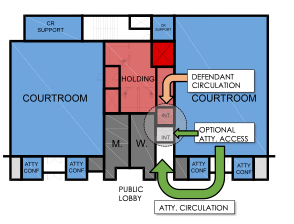
The Case for Proximity – Security Benefits
From a law enforcement perspective, two immediate benefits of a secure interview room near the courtroom come to mind:
- Reduced workforce – Moving a defendant to the central cellblock whenever a private discussion is requested requires a substantial workforce. In most cases, the prisoner must be moved to the basement and returned to the courtroom floor upon completion of the conference. Having a secure interview room near the courtroom would dramatically reduce the time and resources required to transport prisoners and could even reduce the size of the overall cellblock. In most cases, the officer stationed in the courtroom could coordinate the movement of prisoners for these ad hoc conferences.
- Reduced cellblock congestion - On a busy docket day, you can imagine the chaos of several attorneys lined up outside the central cellblock asking to speak with a defendant during or after a proceeding, while attorneys and defendants are also returning to the cellblock area for brief conferences in the middle of proceedings. Much of this traffic could be eliminated, and security could be enhanced by providing space near the courtroom for short meetings.
Planning for the Future
The evolution of the attorney/prisoner interview room is an exciting development in courthouse planning. As more emphasis is placed on the right to privacy for in-custody defendants and on facilitating complete and effective communication between the court and the defendant, the attorney/prisoner interview room will continue to take on more significance.
Suppose you are planning a new courthouse or courthouse renovation project. In that case, I would like you to speak with law enforcement, the judiciary, and the local bar association to determine whether providing an attorney/prisoner interview room adjacent to one or more courtrooms in your courthouse is possible.
__________________________________________
Click on the image below to download the Courthouse Security Guide.




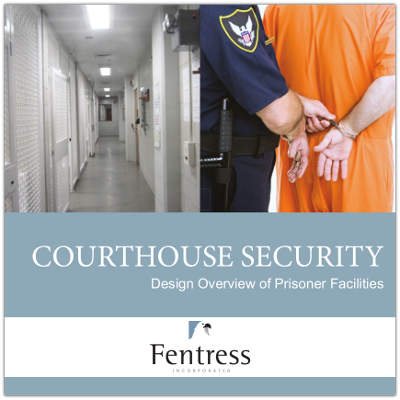
.jpg)
.jpg)
.jpg)
.jpg)
.jpg)
.jpg)


.jpg)
-1.jpg)
.jpg)
.jpg)
.jpg)
.jpg)
.jpg)
.jpg)

